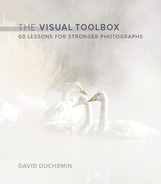Lesson 42. Use Your Negative Space
Negative space is the space in a photograph that is not your main subject. In the case of a portrait made with a very shallow depth of field, the negative space would be the blurred background that contrasts with your subject, better defining her and giving you something with which to create balance and/or tension. What you do with that negative space is important because, contrary to what the name implies, it is not the absence of space; it’s a compositional element that determines how freely the eye moves about the image, and whether the eye is given a place to rest. It’s important as well to remember that this space isn’t necessarily “empty”—it can be textured or colored, or contain details, but not so many that they distract and become subjects of their own.
Nikon D800, 200mm, 1/160 @ f/7.1, ISO 400
The crane in the foreground is the subject of this image. Almost everything else is negative space, making a simple, elegant photograph.
“Learn to anticipate the blur of a wide aperture or the compression of a long lens, and imagine how you might play with this negative space to frame your subjects.”
What can make negative space so hard to grasp is that we don’t see it naturally. When we look around the three-dimensional world, we naturally see first what we’re looking at and disregard the context a little. But when you learn to see the way the camera does—which is in two dimensions—the context gets flattened against the subject, making the relationship between them impossible to ignore. Forcing yourself to see negative space, to look through the camera—and later at scenes without the camera at all—and see it in two dimensions, or flattened, is a great first step. Patches of open sky in the background can become squares of blue in the photograph, so learn to see them that way. Learn to anticipate the blur of a wide aperture or the compression of a long lens, and imagine how you might play with this negative space to frame your subjects.
The well-meaning advice that encourages photographers to “fill the frame” often gets misapplied, and new photographers get in so close that they all but eliminate the negative space. A frame can be filled with negative space, and some of the most elegant compositions have a bold amount of negative space. It is not, however, a simple matter of whether or not you have a lot of negative space—it’s how you use it and why.
Look at some of the images that accompany this book and consider the following questions:
• Can you readily identify the negative space in each image?
• Does the negative space distract from the main subject or serve to draw your eye toward it?
• How does the negative space balance against the positive space (the main subject)?
• Imagine two alternate versions of the particular image you’re studying. What would it look and feel like with twice as much negative space? What would it look and feel like with less?
• Notice the way your eye reads these images and the path it takes. Does it feel rushed, or does the negative space give you a little breathing room before returning to the main subject?

